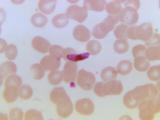Oct 16, 2012
Fair-linked North Carolina E coli outbreak grows to 46 cases
The North Carolina Department of Health and Human Services (NCDHHS) said today that an Escherichia coli O157:H7 outbreak linked to attendance at the Cleveland County Fair has grown to 46 cases. The outbreak, first announced Oct 11, includes the death of a 2-year-old. Six counties in North Carolina and two in South Carolina have reported cases, though the most (22) have been reported in Cleveland County. Case-patients include 29 children and 17 adults, and 10 have been hospitalized. The fair was held Sep 27 through Oct 7. Fair officials said they are working with local and state health officials to identify the source of the outbreak. In 2011, an E coli outbreak linked to a livestock building at the North Carolina State Fair sickened 27 people.
Oct 16NCDHHS update
Cleveland County Fair Web site
Study: Antibody treatment protects macaques from Ebola
A mixture of three monoclonal antibodies (mAbs) that can be produced in tobacco plants fully protected rhesus macaques from normally lethal Ebola virus infections, according to a report in the Proceedings of the National Academy of Sciences (PNAS). When the animals were treated 1 hour after infection, they all survived; when treated 24 or 48 hours after infection, 4 of 6 macaques survived, according to the report. The antibody mixture is the product of more than a decade of cooperation between government and industry partners, according to a press release from the US Army Medical Research Institute of Infectious Diseases (USAMRIID). "It is rare that an antiviral compound prevents Ebola virus infection with limited to no morbidity in treated animals at any point of treatment following infection by this lethal virus," lead investigator Gene Olinger, PhD, a USAMRIID virologist, said in the press release. "Until recently, attempts to utilize antibodies to provide protection against Ebola virus have been met with failure." The antibodies are produced in Chinese hamster ovary cells and tobacco plant cells, the report says. Olinger said efforts are under way to prepare the antibody mixture for clinical safety testing.
Oct 15 PNAS abstract
Oct 15 USAMRIID press release
Yale New Haven Hospital unit wins national award for cutting infection rate
The Saint Raphael Campus of Yale New Haven Hospital received the 2012 Partnership in Prevention Award for making the greatest sustainable drop in rates of healthcare-associated infections, national infection control societies announced yesterday. From 2009 to 2011, the Saint Raphael Campus intensive care unit's rate of central line–associated bloodstream infections dropped from among the highest in Connecticut to one of the lowest: from 3.99 to 0.18 infections per 1,000 central line catheter days, the Association of Professionals in Infection Control and Epidemiology (APIC) said in a press release. The success was attributed to several interventions, including the Institute for Healthcare Improvement’s Central Line Bundle, tools gained from the Connecticut Hospital Association's collaboration with the Johns Hopkins "On the CUSP: Stop BSI" program, and locally developed measures. Three other hospitals received honorable mentions in the award competition: Denver Health Medical Center, Mayo Clinic Florida in Jacksonville, Fla., and Shore Health System in Easton, Md. The annual award is cosponsored by APIC, the US Department of Health and Human Services, and the Society for Healthcare Epidemiology of America.
Oct 15 APIC press release
Drug combo trial shows malaria-prevention benefits in Mali kids
A pilot project in Mali of a combination drug treatment to prevent malaria in children is showing promising results, according to a report today from IRIN, the United Nations' humanitarian news service. The trial, launched by Doctors Without Borders (or Medecins Sans Frontieres [MSF]) in August, involved a 3-day course of the antiparasite medications amodiaquine and sulfadoxine/pyrimethamine during the period of high disease transmission, July through October. About 170,000 children in Koutiala district received the treatment. A week after medication distribution, MSF teams saw a 75% drop in malaria cases and a 60% decline in malaria-related hospitalizations. Health workers administer the first oral dose at distribution sites, where mothers are taught how to give the remaining two doses. Sian Clarke, PhD, a malaria expert at the London School of Hygiene and Tropical Medicine, told IRIN that the key to treatment is that it's targeted to the peak period of risk. Mali's health ministry plans to offer the treatment in five regions in 2013 and expand it to the rest of the country in 2014, according to the report.
Oct 16 IRIN report



















